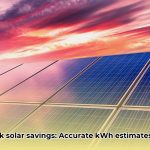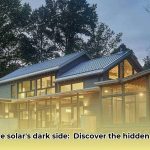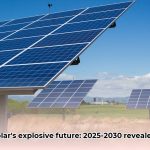Want to get the most out of your solar panels? Location is everything! This guide offers practical tips to boost solar energy production, from understanding sunlight patterns to overcoming shading issues and leveraging the latest tech. Discover how your location impacts solar efficiency and make smart choices for big savings over time. To learn more about daily solar panel energy production, check out this helpful resource: solar panel energy output.
How Location Affects Solar Energy Efficiency
Where you put your solar panels really matters. Factors like how far you are from the equator, how high up you are, the weather, and whether there’s shade all play a big part in how much energy you get. Let’s dive into these things so you can get the most from your solar setup.
Sunlight’s Prime Zone: Latitude and the Sun’s Energy
Being close to the equator means your solar panels get more direct sunlight. The closer you are, the stronger the sun’s rays, which means your panels will produce more power. This is because the sun’s light hits the panels straight on, rather than at an angle, so more energy is captured.
High-Altitude Boost: Getting More Power Up High
If you’re at a higher altitude, the air is thinner, so there’s less stuff to scatter and absorb sunlight. This means more sunlight reaches your solar panels, leading to more power and better energy conversion. Mountain areas often do better than places lower down.
Weather Matters: Temperature and How Panels Perform
When it gets super hot, solar panels don’t work as well. Mild weather with lots of sunshine is best because it stops the panels from overheating. A nice climate helps keep energy production steady and high.
Shade and Obstacles: The Sneaky Energy Blockers
Shadows from trees or buildings can seriously cut down on how much energy you get. Before you put up your panels, check for shade to make sure they’ll get sunlight all day long. Keeping things clear is key for good solar panel performance.
Panel Placement: Getting the Best Angle for Sun
If you’re in the Northern Hemisphere, point your panels south to get the most sunlight. Change the angle with the seasons to follow the sun and get the most energy. The right angle and direction are super important for turning sunlight into power effectively.
Tech Solutions: Boosting Power in Tricky Spots with Solar Inverters
Solar trackers move your panels to follow the sun throughout the day, so they’re always in the best spot for capturing energy. Bifacial panels can grab light from both sides, which is great in places with snow or other reflective surfaces, helping you get more solar power overall.
Checking Your Site: The First Thing to Do Before Going Solar
Before you buy anything, have someone check out your site. They’ll look at sunlight, shade, and the weather to figure out where to put your panels for the best results. This makes sure you get the most energy and the best return on your investment.
Government Help: Rules and Perks for Green Energy
Government rules, net-metering programs, and building codes can make solar panels more affordable. These incentives can make solar energy a better deal and help build a more sustainable energy system.
Full View: Location Is Key for a Strong Solar Future
Where you put your solar panels is crucial for success. Think about the geography, weather, shade, and available technology to get the most out of them. Smart planning and new tech can help, even if your location isn’t perfect.
How to Set Your Solar Panel Tilt for the Seasons to Maximize Power
Changing the angle of your solar panels based on the seasons helps you get the most energy. You’ll need to understand how the sun moves, use online tools, and think about your local area to get the best performance and not rely so much on the grid.
Main Points:
- Changing the tilt can boost energy production by 10-25%.
- Your latitude is a good starting point, but you’ll need to do some calculations.
- What’s happening in your local area matters for the best tilt angle.
Why Tilt Matters: Understanding the Sun’s Path
The sun’s position changes throughout the year, which affects how well your solar panels work. In winter, use steeper angles to catch the sun’s lower rays. In summer, use shallower angles to avoid overheating. Adjustments will help you soak up the most energy.
Your Step-by-Step Guide to Setting the Perfect Angle
- Find Your Latitude. This is the starting point for figuring out your angle.
- Use Online Tools. PVGIS has information that can help you figure out the best tilt angles for different times of the year.
- Think About Your Local Area. Consider trees or buildings that might cast shadows, as this will affect your ideal tilt.
- Consider Your Roof. The angle of your roof will affect your mounting options and how adjustable they are.
- Pick Your Mounting System. Fixed, adjustable, or tracking systems each have their pros and cons.
Tweak Seasonally: Getting the Most Energy
Adjust your tilt angle by roughly ±15° from your latitude: add 15° in winter, subtract 15° in summer to really boost energy production. These are just general tips. Adjust them to get the best output.
More Things to Think About
- Bi-facial Panels: The best tilt angle might be different because of light reflecting off the ground.
- High Temperatures: If you live in a hot area, use flatter angles to avoid overheating.
Types of Systems: Which One Is Best for You?
| System Type | Pros | Cons |
|---|---|---|
| Fixed-Tilt | Cheap, easy to install | Doesn’t produce as much energy as adjustable or tracking systems |
| Adjustable-Tilt | Produces more energy than fixed-tilt, fairly easy to adjust | Costs more than fixed-tilt |
| Tracking Systems | Produces the most energy, automatically adjusts to the sun’s position | Costs the most, harder to install and maintain |
Making small angle adjustments and thinking about all the different factors can really boost your energy production.
How to Boost Solar Efficiency in Different Climates
Making solar energy systems work well in different climates means taking a location-specific approach. Things like how much sunlight there is, where you put the panels, the climate, and the cost all play a big part in getting the most energy and making sure your project is worth it.
Main Points:
- Where you put your panels really affects how well they work.
- Latitude, altitude, and climate all affect how much sunlight there is.
- Panel angle and direction are key for getting the most sunlight.
Understanding Sunlight
Solar panels use the sun’s energy (solar irradiance). Areas near the equator get more sunlight than areas further away, which means they produce more solar energy. Altitude also matters; higher altitudes usually mean clearer skies and stronger sunlight.
Getting the Best Angle and Direction
The sun moves differently depending on your latitude and the time of year. Angle your solar panels carefully, usually facing south in the Northern Hemisphere, but the best angle changes with the seasons. Also, make sure to space them out so they don’t shade each other.
How Climate Affects Performance
Clouds, rain, and temperature all affect how well your system works. Hot weather can make panels less efficient, but there are new cooling technologies that can help. Coastal areas might have more clouds, but the ocean’s cooling effect can balance things out.
Other Things to Consider
The cost of land and getting access to the electricity grid also play a role in whether your solar energy project is feasible. Plus, make sure to look into government incentives and local rules.
New Technologies
New panel designs are constantly being developed that work better even in less-than-ideal conditions. This helps maximize the amount of solar power you get.
Getting the Most Energy from Solar Panels in Shady Spots
If your solar panels are in a shady area, you’ll need to plan carefully, adjust the tilt strategically, and use new technology to get the most energy possible. This is super important for keeping efficiency up and making the most of solar energy in less-than-perfect places.
Main Points:
- Panels facing south usually get the most energy, but smart placement can help you overcome shade.
- The right tilt angle, based on your latitude, is key for getting as much sun as possible.
- Shade really hurts efficiency. You’ll need strategies to deal with it.
Why Shade Is a Problem
Shade from trees or buildings can really cut down on how much energy a solar panel produces. But, with careful planning and the right technology, you can still get good results.
How to Maximize Sunlight in Shady Areas
You’ll need to do a thorough site assessment, looking at the sun’s path throughout the year. There are professional tools and software that can simulate sunlight patterns and help you reduce the impact of shade.
Tilt Angle
The ideal tilt angle is usually the same as your latitude. But sometimes, changing the angle slightly can improve performance, even if it means sacrificing some ideal sun exposure.
Using Technology to Your Advantage
Microinverters allow each panel to work at its best, even if others are shaded, so one shadowed panel doesn’t affect the whole system. Also, think about using bifacial panels
- Hydro Extrusions USA Leads North American Aluminum Profile Solutions - December 28, 2025
- Hydro North America Leads Aluminum Extrusion Solutions Across Diverse Industries - December 27, 2025
- Hydro Extrusion North America Provides Custom Solutions Across Diverse - December 26, 2025















